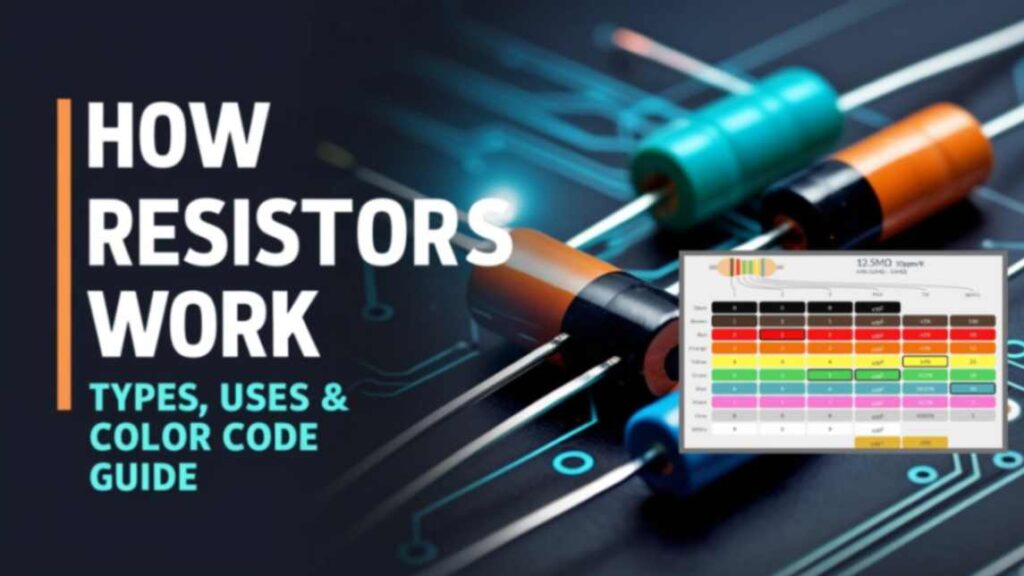
If you’re diving into the world of electronics, one of the first components you’ll encounter is the resistor. Despite its tiny size, a resistor plays a massive role in managing the behavior of electrical circuits.
In this comprehensive guide, we’ll explore:
What a resistor is
How it works (with real-world examples)
Different types of resistors and their specific use cases
Practical applications
The resistor color code system
Tips for identifying and using resistors correctly
Let’s get started with the basics.
What is a Resistor?
A resistor is a passive two-terminal component that resists the flow of electric current. Its main job is to limit or control the current flowing through an electrical circuit.
Key function:
To drop voltage, limit current, and divide voltage across components, thereby protecting sensitive parts like LEDs, microcontrollers, and transistors.
How Does a Resistor Work?
A resistor is a passive electronic component that opposes the flow of electric current. It does this by converting electrical energy into thermal energy (heat), following fundamental physical laws of electron motion in conductive materials. This function is vital in protecting sensitive components, managing voltage levels, and controlling current flow in a circuit.
Understanding Resistance at the Atomic Level:
Electric current is the movement of free electrons through a conductor. When electrons pass through a material like carbon, metal oxide, or metal film (the common resistive materials), they interact with the atoms of that material.
As electrons collide with these atoms, their motion becomes hindered by these interactions, which slows them down and dissipates energy. This energy loss shows up as heat — a principle described by Joule’s Law:
Power loss (P) = I² × R
This heat dissipation is not just a by-product — it is central to the resistor’s ability to limit current. The higher the resistance, the more opposition to current flow, and the more energy is lost as heat.
The Physics Behind It:
A resistor follows Ohm’s Law, which is expressed as:
V = I × R
Where:
V is the voltage across the resistor (in volts)
I is the current through the resistor (in amperes)
R is the resistance (in ohms, Ω)
This equation means that the higher the resistance (R), the less current (I) flows for a given voltage (V).
Real Example:
If you connect a 9V battery across a 1kΩ resistor:
I = V / R = 9V / 1000Ω = 0.009 A (or 9 mA)
This current is low enough to safely power an LED, for example, without burning it out.
What Happens Inside a Resistor?
Inside a resistor, the material opposes the free flow of electrons, causing:
Loss of energy as heat (notice resistors warm up during use)
Reduction in current flow, especially in series connections
Voltage drops across the resistor, which can be used intentionally to power other devices
Key Functions Performed by a Resistor
Limits Current: Prevents too much current from damaging components like LEDs and ICs.
Divides Voltage: Used in voltage divider circuits to get lower voltages from a high-voltage source.
Controls Timing: In RC (resistor-capacitor) circuits, it sets the charge/discharge rate (used in timers and oscillators).
Protects Circuits: In combination with fuses or as fusible resistors, it prevents overcurrent conditions.
Quick Analogy:
Think of electricity like water flowing through a pipe:
The pipe size is like the wire gauge
The valve is the resistor
A narrow valve (high resistance) reduces the flow
A wide valve (low resistance) lets more water (current) through
Types of Resistors (With Examples)
1. Fixed Resistors
Have a specific, unchanging resistance value.
Carbon Composition Resistors
Inexpensive and used in basic circuits.
Example: Toy circuits, educational kits.Metal Film Resistors
Offer high precision and low noise.
Example: Audio equipment, medical devices.Wire-Wound Resistors
Withstand high power and heat.
Example: Power supplies, motor controls.
2. Variable Resistors
Resistance can be manually adjusted.
Potentiometers
3-terminal devices used for voltage division.
Example: Volume knobs, dimmer switches.Rheostats
Control current flow with two terminals.
Example: Industrial motor speed control.Trimmer Resistors
Tiny variable resistors for circuit calibration.
Example: Tuning circuits on PCBs.
3. Special-Purpose Resistors
Used in specific environmental conditions.
Thermistors
Resistance changes with temperature.
Example: Digital thermometers, AC units.Photoresistors (LDRs)
Resistance changes with light intensity.
Example: Street lights, light meters.Fusible Resistors
Act like a fuse and resistor together.
Example: Safety circuits in appliances.
Real-Life Applications of Resistors
Resistors are used across a wide range of electronics applications, including:
Voltage Regulation:
Used to divide voltage between components in a series.
Current Limiting:
Protects LEDs from drawing too much current and burning out.
Logic Circuits:
Used as pull-up or pull-down resistors in microcontrollers to maintain stable digital inputs.
Timing Applications:
Used in RC (Resistor-Capacitor) timing circuits for oscillators and timers.
Signal Conditioning:
Help adjust and filter signal levels in audio systems and sensor circuits.
Safety Mechanisms:
Fusible resistors prevent excessive current flow by breaking the circuit.
Understanding Resistor Color Code
Resistors usually don’t have printed numerical values. Instead, a color code system is used to denote resistance and tolerance.
How to Read a 4-Band Resistor:
Band 1: First digit
Band 2: Second digit
Band 3: Multiplier (powers of 10)
Band 4: Tolerance (% of error allowed)
Color Chart:
| Color | Digit | Multiplier | Tolerance |
|---|---|---|---|
| Black | 0 | ×1 | — |
| Brown | 1 | ×10 | ±1% |
| Red | 2 | ×100 | ±2% |
| Orange | 3 | ×1k | — |
| Yellow | 4 | ×10k | — |
| Green | 5 | ×100k | ±0.5% |
| Blue | 6 | ×1M | ±0.25% |
| Violet | 7 | ×10M | ±0.1% |
| Gray | 8 | ×100M | ±0.05% |
| White | 9 | — | — |
| Gold | — | ×0.1 | ±5% |
| Silver | — | ×0.01 | ±10% |
Example:
A resistor with Red, Violet, Orange, Gold means:
Red (2), Violet (7), ×1000 → 27,000 ohms or 27kΩ ±5%
How to Identify and Use Resistors Properly
Use a Multimeter: To verify resistance, especially if color bands are unclear.
Check Tolerance: For precision circuits, choose resistors with low tolerance values (±1% or ±0.1%).
Verify Wattage: Make sure the power rating (1/4W, 1/2W, etc.) matches your circuit requirement.
Use Color Code Calculators: For beginners, online tools help avoid confusion.
Pro Tips for Beginners
Start with 220Ω or 1kΩ resistors for LED circuits.
Avoid mixing up brown and red bands—they can look similar.
Keep a resistor value chart or app handy during prototyping.
Organize resistors in labeled compartments to save time during projects.
Conclusion
Resistors are the unsung heroes of the electronics world. From a blinking LED to complex logic gates in microcontrollers, resistors ensure your circuits function smoothly and safely. Understanding resistor types, their functions, and how to read their values using color codes will empower you to build better, more reliable electronics projects.
Want More?
Stay tuned to pluntx for upcoming posts on capacitors, transistors, and other essential components. Follow us on Instagram for DIY tips, tutorials, and component discounts!
About pluntx

Pluntx is India’s leading platform for electronics and 3D printing solutions, offering a wide range of products like Arduino, Raspberry Pi, drone parts, sensors, 3D printer components, and more. We also provide expert CAD design services and affordable 3D printing, starting at just ₹49. Click here to explore our extensive collection of electronics and prototyping tools. Be sure to follow us on Instagram and YouTube, where we regularly share tutorials, tips, and updates on everything from Arduino projects to drone technology. Pluntx delivers precision and quality. Our mission is to empower creativity through technology and simplify the journey from concept to creation.


